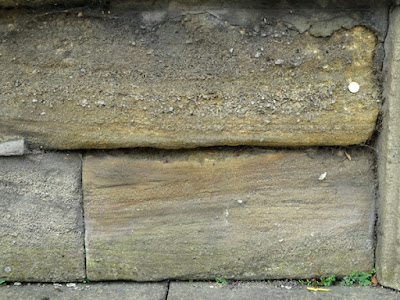Taking advantage of the continuing good weather in October 2018 – after a very productive trip to Ashford-in-the-Water – my next day out coincided with a planned trip to the Manifold Valley with the Sheffield U3A Geology Group. On this occasion, I was a bit disorganised and I was unable to obtain a lift but, being determined to go out, I decided to take another trip to Leeds – this time using The Building Stone Heritage of Leeds to guide me around.
I have visited Leeds many times in the past 35 years and I know its principal historic buildings reasonably well, although I haven’t examined the building stones of any of them in detail, except Kirkstall Abbey and Leeds Central Library. Having skimmed through the book to find some other interesting buildings, whilst on the train from Sheffield, I decided to visit St. Peter’s church, which was rebuilt 1838-1841 on the site of four previous churches – the earliest dating to the 7th century – and renamed Leeds Minster in 2012.
Approaching from the west along Kirkgate, with the main entrance to the church being beneath the tower that is unusually built in the middle of its north elevation, it would be easy to miss some of its interesting features – the Leeds Rifles war memorial and the East Bar.
The East Bar is an inscribed block of sandstone set into a boundary wall that marks one of the boundaries of the mediaeval town. Although probably renewed when the church was rebuilt, it is made of a very coarse grained sandstone from the Rough Rock, which was used to build Kirkstall Abbey and has since been used in very many buildings in and around Leeds, together with finer grained sandstone from the Coal Measures.
Apart from its historic interest, the section of walling into which the East Bar is set contains examples of the Rough Rock that have educational value. Students of geology are taught that the sediments that comprise the Millstone Grit were formed in an environment analogous to the modern Mississippi River and its delta, with meandering river channels frequently bursting their banks – forming temporary lakes.
Out in the field, such as in the Peak District National Park, the coarse grained sediments with cross bedding are interpreted as being laid down in river channels but the overspill deposits are usually well bedded and much finer grained. I have seen many examples of both types of sandstone – in natural outcrops and quarries – but you very rarely see these together in a single block of walling stone.
When quarrying stone and subsequently using it for building, a fundamental principal of stonemasonry is that the individual blocks of stone should be laid on their natural bed in a building. To the best of my knowledge, it makes no difference to the structural integrity of a building if a block of stone is laid upside down, although it might look odd.
For the field geologist, however, cross bedding and graded bedding – which is clearly visible here – are used to determine the way up of strata, which are often overturned in regions that have been subjected to mountain building events.
 |
| A detail of graded bedding in the Rough Rock |








No comments:
Post a Comment